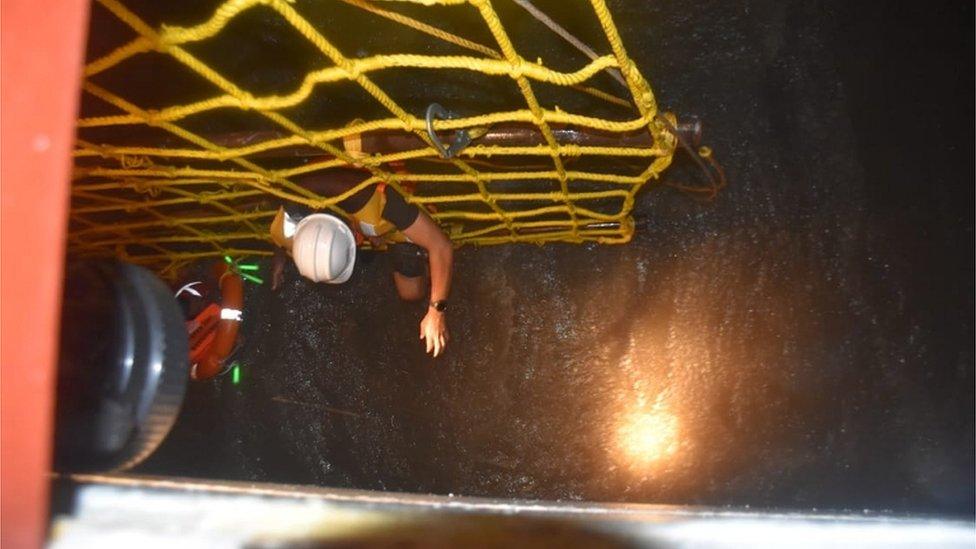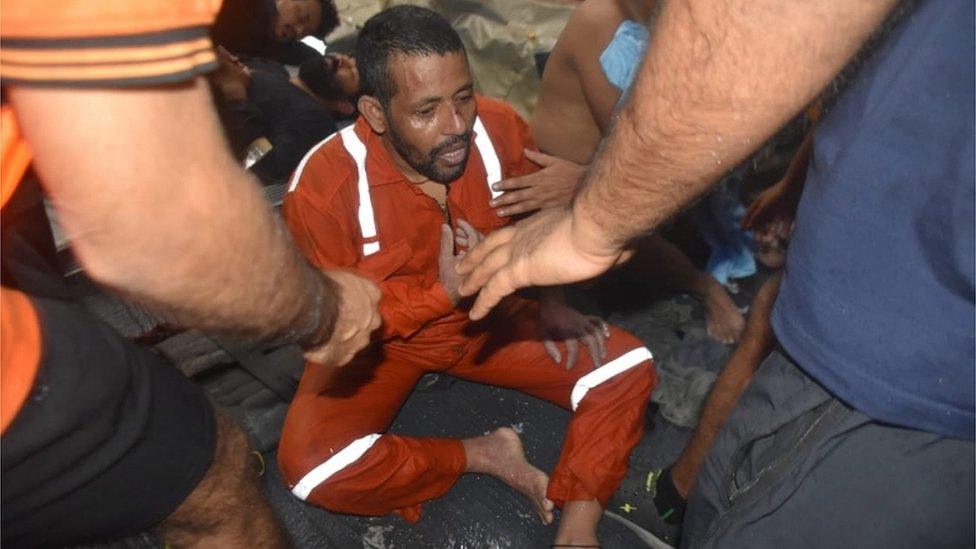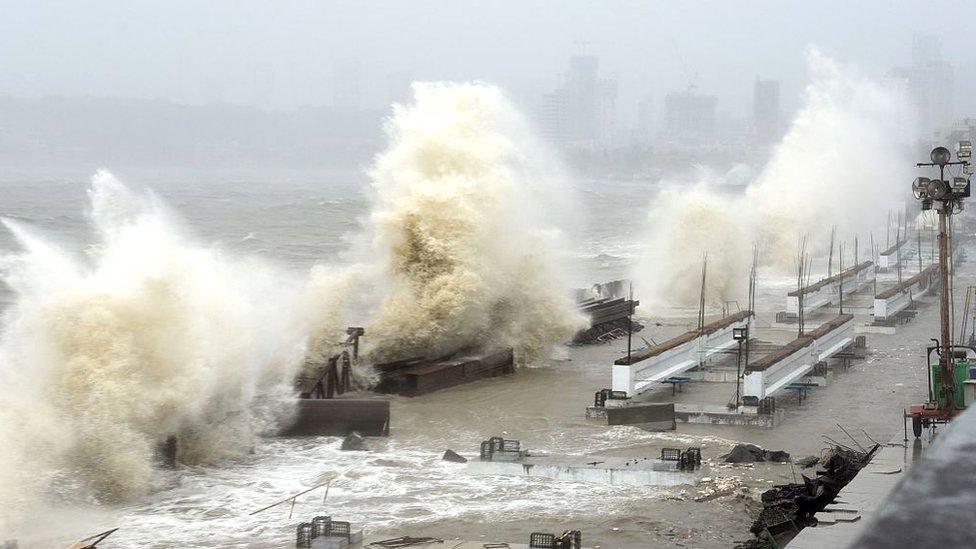Cyclone Tauktae: Survivors recount horrific tragedy on sunken barge
- Published

The Indian navy says it has recovered 70 bodies
Vishal Kedar says he will never forget the night of 16 May when the barge he was deployed on began to sink amid a severe cyclone off the coast of the Indian city of Mumbai.
There were 261 workers on the barge when it sank. Seventy bodies, believed to be mostly from the barge, have been recovered so far, and 186 men have been rescued.
Mr Kedar was employed as a welding assistant on the barge called Papaa-305 (P-305) which, on the evening of 17 May, finally sank in the Arabian Sea, about 60km (37 miles) miles off the coast of Mumbai.
The stricken vessel, deployed by India's Oil and Natural Gas Corporation (ONGC), was carrying personnel hired for offshore drilling.

Vishal Kedar (L) and Abhishek Awadh (R) were working as welders on the barge
Mr Kedar and his friend Abhishek Awadh, both 20, worked on the vessel as welding assistants, each earning 20,000 rupees ($274; £194) a month.
Mr Awadh says that on 14 May, the captain of the barge was warned about the cyclone by India's meteorological department. The coastguard said Cyclone Tauktae would hit the sea and that all vessels should return to Mumbai.
"But the people managing the barge did not take note of the warning. They thought that seven to eight metre-high waves would pose no dangers. So the vessel was taken 200m away from the [oil rig] platform at which we were working," says Mr Awadh.
An official investigation has been launched to find out why the barge was stranded in the storm, and a police complaint has been lodged against the captain.
In a statement on 19 May, Afcons, the company which chartered the barge, said the vessel had been carrying safety equipment including life jackets and life rafts for all personnel. The BBC has contacted Afcons for comment.
When the storm struck, the barge's anchors gave way and it began drifting. Then the vessel rammed into an oil drilling platform.
"This led to a puncture in the barge and water started gushing in from one side. After sometime, the rear portion of the vessel started sinking and the engine room got flooded," says Mr Kedar.
The radio officer on board tried to contact the company's Mumbai office to seek help. Panic had started setting in.
Around 20 workers jumped into the sea and most of them drowned almost immediately, Mr Awadh says.
Early on 17 May, navy ships carrying rescue teams began arriving at the site.
Choppy waters, strong winds and low visibility made it difficult for them to come close. To add to the woes, the barge's power supply had snapped and the vessel had strayed almost 90km (56 miles) in the sea from the spot it was anchored at.
Allow X content?
This article contains content provided by X. We ask for your permission before anything is loaded, as they may be using cookies and other technologies. You may want to read X’s cookie policy, external and privacy policy, external before accepting. To view this content choose ‘accept and continue’.

"The rescue teams told us if their boats came near us, they might hit the barge and cause further damage," says Mr Kedar.
"They asked us to wait until the weather cleared up a bit so they could see us better. But we did not have much time to wait. Everyone's hopes were broken."

Rescue teams found it difficult to reach survivors due to choppy waters and low visibility
With water gushing in, the barge was sinking slowly, just "like it happened with the Titanic," says Mr Kedar.
Mr Awadh says the men aboard held each other's hands and decided to jump into the water in groups so that the rescue teams could find them together at one place.
He says when he fell into the sea, he felt that he was sure that he would die.
"But our colleagues kept encouraging each other and asked us not to lose hope. They said we will be safe, just like the way it happens in movies."
The rescue teams had flung ropes and life rafts in the water. "But when we jumped into the water, we found [many of the] life rafts had punctures in them," says Mr Avadh.
"It felt as if I was tasting death at that moment."
The next few hours were spent trying to stay afloat in the cold water. Some would try to swim towards the navy ship but the strong waves would throw them hundreds of metres away before they could even reach the ship.

Many of the survivors spent hours afloat in cold waters before being pulled to safety
"We kept trying but eventually we lost hope and accepted our fate. Some of us took off our life jackets and embraced death. Even I thought about doing the same," says Mr Kedar.
A little after midday on 17 May, the survivors managed to grab on to the ropes.
"I tried to swim and then grabbed the rope and climbed up. I almost fainted. We couldn't even understand whether it was day or night," says Mr Awadh.
Cyclone Tauktae has battered coastal India
Related topics
- Published11 December 2017

- Published19 May 2021

- Published19 May 2021
